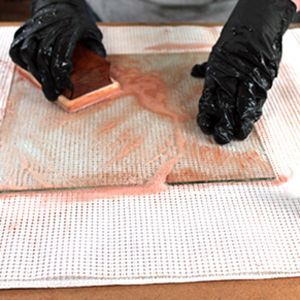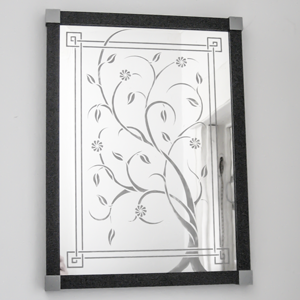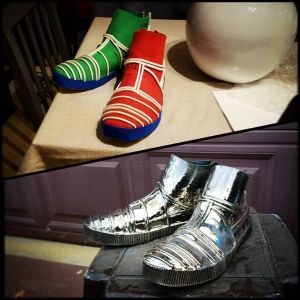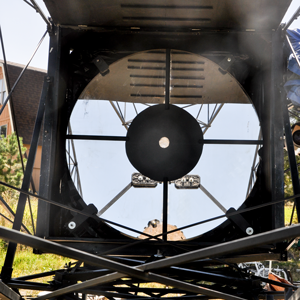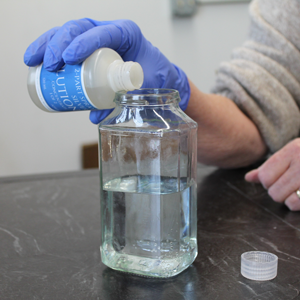Cleaning and Polishing
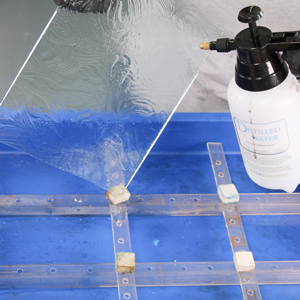

A clean, wet, high-gloss surface is essential to successful mirroring.
Even the lightest fingerprint creates a barrier between the chemicals and the substrate.
We have a cleaning and polishing video that shows you how we prepare different shapes and surfaces for mirroring.
This page has extra tips and tricks and advice for problem areas.


Cleaning
Any exposed surface has dust, grease and fingerprints on it. These must be removed for the mirror to take. The inside of an object to be mirrored also has particulates on the surface though not fingerprints. Cleaning is the process of removing these without adding back films or smears of suspended contaminants. Even a newly-blown glass object benefits from a light cleaning before mirroring if only to get the water to flow freely over the surface.
- Wear rubber gloves to avoid adding your own fingerprints to the glass and to protect your hands from cleaning materials.
- Use warm or hot tap water for cleaning. The water from most hot water taps is about 140 ° F. (60 °C.) but tepid 110 ° F. (43 °C.) water can also be used.
- Use a clean-rinsing laboratory grade cleaner like our Liquid Cleaner. Many commercial cleaners like Windex™ or Dawn™ leave a invisible film that blocks the mirror chemicals. Bon Ami™ cleanser, while useful for leaf gilding, is not suitable for chemical mirroring.
- Pay special attention to the edges of flat glass. Not only do most people hold flat glass by the edges, but there may be oil left on the glass from the glass cutter.
- After you strip paint from the back of an existing mirror, you may need to remove the waxy residue with acetone before cleaning it with glass cleaner.
- Always use distilled water to rinse off all traces of tap water as the last step in the cleaning process.


Polishing
Polishing with an abrasive can help to remove stubborn dirt on any type of glass. Most plastics are too soft to polish and abrasives can ruin the glass-like surface. We recommend using new plastic for mirrors. See our page on mirroring plastics for more information.
Each abrasive has its own characteristics. Sprinkle a small amount on the surface and add hot water to make a slurry. Use a pure wool felt polisher to scrub the surface. Synthetic polishing materials can scratch the glass. Use a clean sponge or brush to physically remove the used compound. Finish with a spray of distilled water.
it is not necessary and often not possible to polish the inside of a glass container. Not only is it difficult to reach but it is usually not covered with fingerprints or other random contaminants.
- Cerium Oxide is the best cleaner for flat glass. It polishes by abrasion and by a chemical reaction with the glass. It must be physically wiped off the glass with a sponge or clean paper towel. It has replaced it messier cousin, rouge or iron oxide, for most glass fabrication.
- Whiting, also known as calcium carbonate, is an inert white powdered chalk often used to polish the face of a mirror
- Extra-fine pumice is a more aggressive abrasive that is very useful for removing backing paint


Wetting
The easiest way to test if the surface is clean enough for mirroring is the "water break test". A thin layer of water should cover the surface in a continuous sheet for at least a minute without pulling way or rolling off it - it "sheets" over the glass and "wets" the entire surface.
It can be very difficult to get water to sheet over a plastic surface such as a base coat. We have two solutions to this problem:
- Wetting Agent is a surfactant which breaks the surface tension of the water droplets causing them to flow out.
- Flame Treating is a process that breaks the long chain polymer molecules in plastics causing them to attract, rather than repel, water molecules.
Special Cleaning Problems
Water etching occurs on glass surfaces that have been left partly covered with water for a long time. It is almost impossible to remove without mechanical grinders or polishers. It is often easier to replace the glass than try to fix this.
Alcoholic beverages can permanently work their way into glass. If you try to silver the inside of a vodka bottle with silver, you may be surprised at the beautiful antique silver you get. Glass is porous and the longer it is in contact with a substance, the more of that substance it will absorb.
Tempered glass has to have the edges polished before it goes into the tempering furnace. The lubricant used for polishing can be oil or water. If oil is used, it will bake into the surface and be impossible to remove. If you are getting your glass tempered, ask the company to use water for polishing.
Beveled glass is usually polished with water and mirrors easily. If the edges repel water, the beveler may have used oil to create the bevel.
Troubleshooting
A sure sign of inadequate surface preparation is an uneven mirror. This will often show up as thin mirroring on the edges where most of the handling has been done. Incomplete removal of cleaning compounds such as cerium oxide can also lead to unsatisfactory results. If in doubt, make sure that the water sheets from the surface and does not bead up, especially at the edges.

